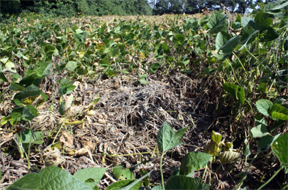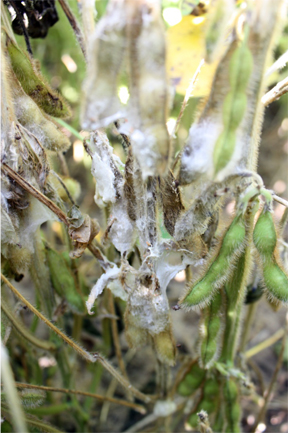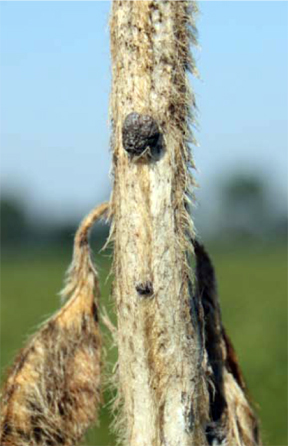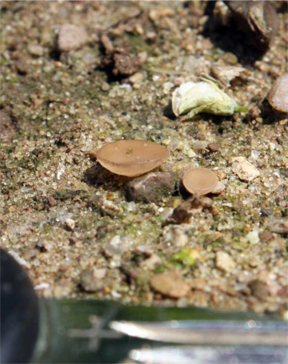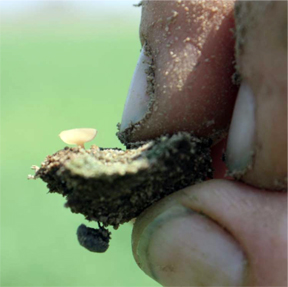Sclerotinia stem rot of soybean, identification, factors and management
Editor’s note: This article is from the archives of the MSU Crop Advisory Team Alerts. Check the label of any pesticide referenced to ensure your use is included.
Sclerotinia stem rot or white mold caused by the fungus Sclerotinia sclerotiorum resulted in extensive soybean losses across the North Central region of the United States in 2009. In this article, we will discuss how to identify the disease, factors that influence disease development and possible management options.
Signs and symptoms of Sclerotinia stem rot in soybeans
Symptoms of infection include areas of wilting during late reproductive stages, which are often visible in patches across the field, severe infection will weaken the plant and result in lodging (Figure 1). Signs of the pathogen include the production of white-cottony mycelium (mold) and the production of sclerotia (Figure 2). Sclerotia are resting bodies of the fungus and may be produced inside or outside stems and pods and resemble mouse or rat droppings. These signs and symptoms of Sclerotinia stem rot allow it to be distinguished from the many other diseases of soybean. A general rule of thumb is that a 10 percent incidence of Sclerotinia stem rot will result in losses of 5-10 bu/acre.
Disease cycle
The disease cycle of Sclerotinia stem rot is driven by environment, host and presence of the pathogen. The role of environment is very important on disease development. Sclerotia overwinter in the soil and germinate under appropriate moisture and light conditions to produce distinctive apothecia (small mushrooms) (Figure 3). Spores released from apothecia typically infect the plant through flowers, and infection of flowers is favored by canopy closure during flowering (R1-R3) which creates a microclimate within the crop canopy. Factors that favor the occurrence of Sclerotinia stem rot include, a high yield potential crop, field history of Sclerotinia stem rot, previous susceptible crops in the rotation, cultivar susceptibility, narrow row width, high plant populations, high soil moisture, high relative humidity and cool temperatures (less than 90°F).
Cultural management
Long term management should focus on reducing the number of sclerotia in the soil to reduce spore production and plant infection. S. sclerotiorum has a wide host range including soybean, drybean, potatoes, pea, cucumbers etc. Rotation into non-host crops such as small grains and cereals can help to reduce the sclerotia load in the soil however sclerotia are capable of surviving for a number of years. Although corn is a non-host, small grains such as wheat have been demonstrate to be superior in reducing sclerotia load. Tillage also has an effect on Sclerotinia stem rot, with no-till systems having a lower risk of disease development.
Resistance
No cultivars are completely resistant to Sclerotinia stem rot, but partially resistant cultivars are available. Breeding resistant cultivars is difficult as multiple genes are involved in resistance. In addition, screening for resistance is complicated as plants may also escape infection by maturity group i.e. flowering prior to spore release, and plant architecture which can affect the microclimate within the canopy.
Chemical control
Chemical control options are available for the control of Sclerotinia stem rot. A number of foliar fungicides are available for Sclerotinia stem rot control including Domark (tetraconazole), Endura (boscalid), Topsin-M (thiophanate-methyl). The herbicides Cobra (lactofen) and Pursuit (imazethapyr) have also demonstrated efficacy in disease control through modification of the soybean canopy and sclerotia inhibition. When using chemical control options, pay particular attention to the label rate and application timing. Efficacy is a function of canopy penetration and application timing which should be focused on early flowering stages up to R3. Value of the crop and history of disease should be used to determine if a fungicide or herbicide application is warranted.
Biological control
Conithyrium minitans sold as Contans® WG is a fungal pathogen of Sclerotinia sclerotiorum. C. minitans parasites and destroys the sclerotia of Sclerotinia sclerotiorum thereby reducing the sclerotia load in the soil. Research is continuing at MSU within the Hao laboratory on the application timing, quantity and duration of C. minitans survival within the soil for disease control.
Additional resources
- http://www.planthealth.info/whitemold_basics.htm
- http://www.plantmanagementnetwork.org/edcenter/seminars/SclerotiniaStemRotofSoybean/
- http://www.youtube.com/watch?v=rdc7ac60R0M&feature=channel



 Print
Print Email
Email